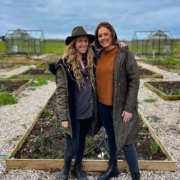Groundbreaking new public artwork to acknowledge contested history in Gladstone Park
A new public artwork for Brent’s Gladstone Park breaks new ground in the conversation over public space with links to the transatlantic slave trade.
On 14 October 2022 Brent Council and Lin Kam Art will present The Anchor, The Drum, The Ship (2022), a groundbreaking public artwork for Gladstone Park designed by the London-based artist Harun Morrison and horticulturalist Antonia Couling.

Groundbreaking new public artwork to acknowledge contested history in Gladstone Park
This is the first time in the UK’s history that a public artwork of this kind has been used to acknowledge the contested history of a green space. The permanent artwork will be unveiled on 14 October to coincide with Black History Month in October.
Titled The Anchor, The Drum, The Ship (2022), this horticultural installation brings together a variety of plant species, native to Britain, the Mediterranean and Africa, across three shapes: the Akan symbol for a Double Drum, a ship and an anchor to evoke themes of Black migration, belonging, communication, music and collective renewal. Plant species have been carefully selected to make sure they were suited to the local ecology.
Gladstone Park is named after former Prime Minister Sir William Gladstone whose family owned plantations in the Caribbean and received the largest of all compensation payments made by the Slave Compensation Commission. The name was identified for review as part of the Commission for Diversity in the Public Realm that launched in 2020 to review statues, street names and landmarks to ensure they reflect London’s rich and diverse history and represent all Londoners.
The London Borough of Brent is one of the most diverse in the UK, with the seventh biggest Black community in London. Brent Council has taken an approach to develop a public art commission with the community which explores the transatlantic slave trade whilst creating a space to reflect, celebrate and amplify hidden histories and Black leaders who have had an influence on Brent. The Anchor, The Drum, The Ship (2022) is the first intervention to be installed in the park. A permanent history trail detailing the history of the park and the Gladstone family involvement in the transatlantic slave trade will follow later in the month.
Councillor Muhammed Butt, Leader of Brent Council, said: “This outstanding public artwork acknowledges the achievements and contributions made to Brent by people of Black heritage and shines a light on some unexplored corners of our local history. “It’s so important that these hidden pasts are embraced as part of the borough’s history, and it’s brilliant that we now have this space for learning, reflection, gathering, celebrating and dreaming.”
The artwork
The constellation of shapes (anchor, drum and ship) that make up The Anchor, The Drum, The Ship (2022) offers a set of triangulation points to create conversation around Victorian aesthetics, plantations, horticulture, colonialism, migration, botany and storytelling. The work is spatially in dialogue with the remnants of Dollis Hill House, a former property that regularly received Prime Minister William Gladstone.
Just as there is a Memorial to Prisoners of War and Concentration Camp Victims, the artwork aims to commemorate the history of Black Britons while celebrating the achievements of one of the largest and most overlooked communities within the borough.
Investigating contested history has become a vital undertaking in recent years. Explaining how and why links to the slave trade and British colonialism might have allowed a person who has been venerated with a statue, monument or place or street name to rise to prominence in the first place sheds light on a dark history that can no longer be left untold. Brent Council hopes that this innovative horticultural installation will lead the way for more projects in the future.
Artist Harun Morrison, said: “I hope the artwork can contribute to a valuable discussion around how representation takes place in public space. Gladstone Park is a microcosm and container of many contested histories, the artwork can be a compass point to navigate this.”
Planting Designer Antonia Couling, said: “It has been very moving to be involved in creating this innovative way of interacting with contested history. A public park belongs to everyone, and I hope that this artwork will become a meeting place for recognition, dialogue and understanding.”
Producer Linett Kamala, said: “As a Brent-based company whose founder has a personal connection to the transatlantic slave trade, it is an honour for Lin Kam Art to be entrusted to deliver this unique and special commission. I hope it will begin to open up a dialogue about this hidden history in the borough, but also celebrate the achievements of those who have contributed so much to the vibrancy of Brent.”
Planting Design
Antonia Couling, a Brent-based garden designer and certified horticulturist has worked with Harun Morrison to bring the vision to life. Antonia wanted to respond to the carefully chosen shapes by providing a design that underpins the powerful statement that Harun is making. She has addressed Harun’s request for perennial planting that will survive in this exposed, dry, sunny site, while providing interest throughout the year. The intention is to leave the majority of plants over the winter (rather than cutting them back) so that the frost-laden stems and flower heads will provide a different – and perhaps ghostly – kind of beauty.
She says:
“The Anchor represents not only associations of all kinds with the sea and what is carried on it, but also the shores of Britain. Sedums and blue grass are planted at the extremities of the anchor on the ‘shoreline’. Running through the central column and branches, however, is a palette of mainly blues and pinks, hinting at an English meadow with its loose grasses and hovering blooms (such as the Gaura and the Centaurea or cornflower), but interspersed are injections of vibrant colour, some shared with the African Adinkra, such as the Geum ‘Totally Tangerine’, and some shared with the Ship, such as the Salvia nemorosa ‘Caradonna’, celebrating the rich cultural mix within those shores.”
“The Adinkra drum planting is inspired by Adinkra designs, replicating their bold stripes and sweeps of intense colour. The link between this planting and the Ship’s planting is most evident in the handful of Verbena in the centre, which will wave tall over the strong identity of the African patterns. African plant species such as the Salvia Africana in the centre, Crocosmia and Gazania (or African Daisy) are included.”
“The ship has a taller spine running along its center to suggest rigging (Fennel, Melianthus and Verbena). Grasses are interspersed with deep purple Salvias, which will waft to give the suggestion of movement. Many of the surrounding plants are also prickly, mirroring the emotions contested history can elicit – that something may seem pleasant enough from a distance, but uncomfortable when seen up close. The low, white Thyme around the edges also hints at sea foam, which is magnified at the front by two Agapanthus.”
With Special thanks to project contributors:
Azul De Mont
Black Community Action Plan Members
Crest Academy
Errol Fernandes
Francine Lawrence – Vice Chair Friends of Gladstone Park
Halime Ozdimir – Creative Producer – Art Producer 360
Mary Vetisse
Samantha Haines – LB Brent Parks Service
Sky Caesar – Assistant Producer – Lin Kam Art
For the latest industry news visit landscapingmatters.co.uk/news
Get all of the big headlines, pictures, opinions and videos on stories that matter to you.
Follow us on Twitter and Instagram for fun, fresh and engaging content.
You can also find us on Facebook for more of your must-see news, features, videos and pictures from Landscaping Matters.












